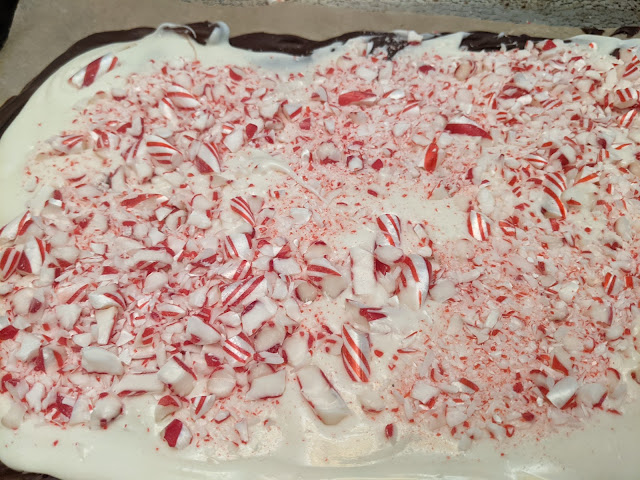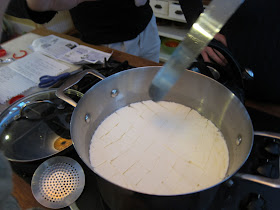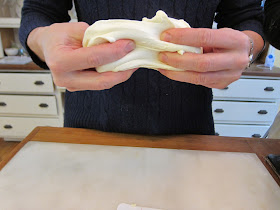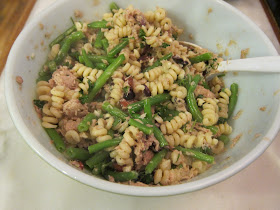Note: Oh, my. This post for so long fell into the category of neglected drafts along with so many others. I haven't been as on top of this blog in recent years as I once was, and so I recently found it just sitting around, last edited years ago. Seems a waste to leave it there (especially since it includes cute pictures of my then-round-faced toddler, and memories with some friends whom we still don't see often enough). So here it is-- maybe it will inspire me to make some cheese again soon...
Fresh mozzarella! All by ourselves in our very own home in about a half an hour.
We have some good friends who we don't see nearly enough. When we saw them one day back in 2013 and the topic of getting together to try making cheese was brought up for the two-dozenth time, they, despite the fact that they had at the time a 1-month-old baby, said, "how about tomorrow?" And so we made it happen.
I never once considered the idea of making cheese until I read Animal Vegetable Miracle. Barbara Kingsolver wrote about how she and her family took a cheesemaking 101 class with the "cheese queen," Ricki Carroll, in her home in Ashfield, Massachusetts and she wrote about how cheesemaking, particularly mozzarella making, was an accessible thing for anyone to attempt in their home. It was enough to get me to take the very same class in the fall of 2012. (At the time, I idealistically thought my children would only ever eat homemade bread and that I'd always have casseroles made up in the freezer and shelves of homemade jams and sauces to draw from; making my own mozzarella fit right into this image.) The class was a great learning experience and a really fun day-long adventure meeting a great variety of interesting people. In the class we learned to make mozzarella, as well as farmhouse cheddar, and ricotta.
I also ordered a kit from Carroll's New England Cheesemaking Company, which included a little recipe book, a thermometer, cheesecloth (not needed for mozzarella), citric acid, rennet, and cheese salt.
On our own at home, the mozzarella process was as manageable as both Barbara and Ricki said it was, and a lot of fun. We made two batches and already were improving our technique with the second round.
Once you have the rennet or rennet tablets and the citric acid, all you need is a gallon of milk. For mozzarella, it can be pasteurized but can not be ultra-pasteurized because the cheese queen said she had tried it and that it doesn't work.
It was a really neat and rewarding process (I mean, we MADE! CHEESE!) and a great activity to do with friends.
I am sad to say that we haven't made it since. But, there's not a time I slice through a ball of fresh local mozz (which, thankfully, we can procure pretty easily around here) and don't briefly realize and appreciate how it was made. As with anything, this makes it taste all the better. But now that the kids are older and no one is 1 month old anymore, we should do it again and more often. It is a little like magic watching it turn from milk to soft but solid cheese in the pot. It is an activity and a meal/snack all in one.
30-Minute Mozzarella
1 gallon milk (pasteurized, but not ultra-pasteurized)
1 1/4 C cool, chlorine-free water
1 1/2 t citric acid
1/4 rennet tablet or 1/4 t single strength liquid rennet
1 t cheese salt
(Supplies needed: dairy thermometer, long knife (I used one meant for frosting cakes), colander, slotted spoon, large (1 gallon) stainless-steel pot)
Dissolve rennet tablet or liquid rennet in 1/4 C cool water and set aside. (Wrap remaining pieces of tablet in plastic wrap and store in freezer.)
Mix citric acid into 1 C cool water until dissolved. Pour into pot.
Pour entire gallon milk into pot and stir vigorously.
Heat the milk to 90 degrees Fahrenheit while stirring.
Remove pot from burner and slowly stir in rennet solution with an up and down motion for about 30 seconds.
Cover the pot and leave it undisturbed for 5 minutes. (This is when the magic happens!)
Check the curd by pressing down gently near the sides of the pot with the back of your hand. It should look like custard, with clear separation between the curd and the whey. If curd is too soft or whey looks milky, let it set for a few more minutes. The longer you let it sit, the easier it is to drain off the whey.
Cut the curd with a knife that reaches to the bottom of the pot. Cut in 1-inch cubes both ways, then at a 45-degree angle. (See photo above for my imperfect version of this.)
Place the pot back on the stove and heat to 105 degrees while slowly moving curds around with your spoon. Stir gently, pulling up with the ladle to cut any remaining big ones.
Take off the burner and continue slowly stirring for 2 - 5 minutes. (More time will make a firmer cheese.)
Ladle curds into a colander (over a bowl) and drain off as much of the whey as you can without pressing the curds too much.
Put curds in a microwaveable bowl and microwave for 1 minute.
Remove and drain off the whey as you gently fold the curds into one piece (knead a bit to squeeze out, stretch, fold, stretch again). Add 1 teaspoon salt.
Microwave another 30 seconds. Drain again and stretch the curd. It must be 135 degrees (or uncomfortable to hold) to stretch properly. Knead from the outside in, in a ball. Stretch it by pulling until it is smooth and shiny. The more you work the cheese, the firmer it will be.
Form cheese into a log or ball or braid it.
When finished, to stop it from further cooking, submerge it in 50 degree water for a few minutes, then ice water for 15 minutes. This will cool it down and allow the cheese to hold its shape and silky texture and keep it from becoming grainy.
Enjoy in any way you would enjoy fresh mozzarella! We had ours on bread layered with pesto and some sort of tomato topping. I don't remember what exactly but I do remember it was delicious and consumed immediately.















































